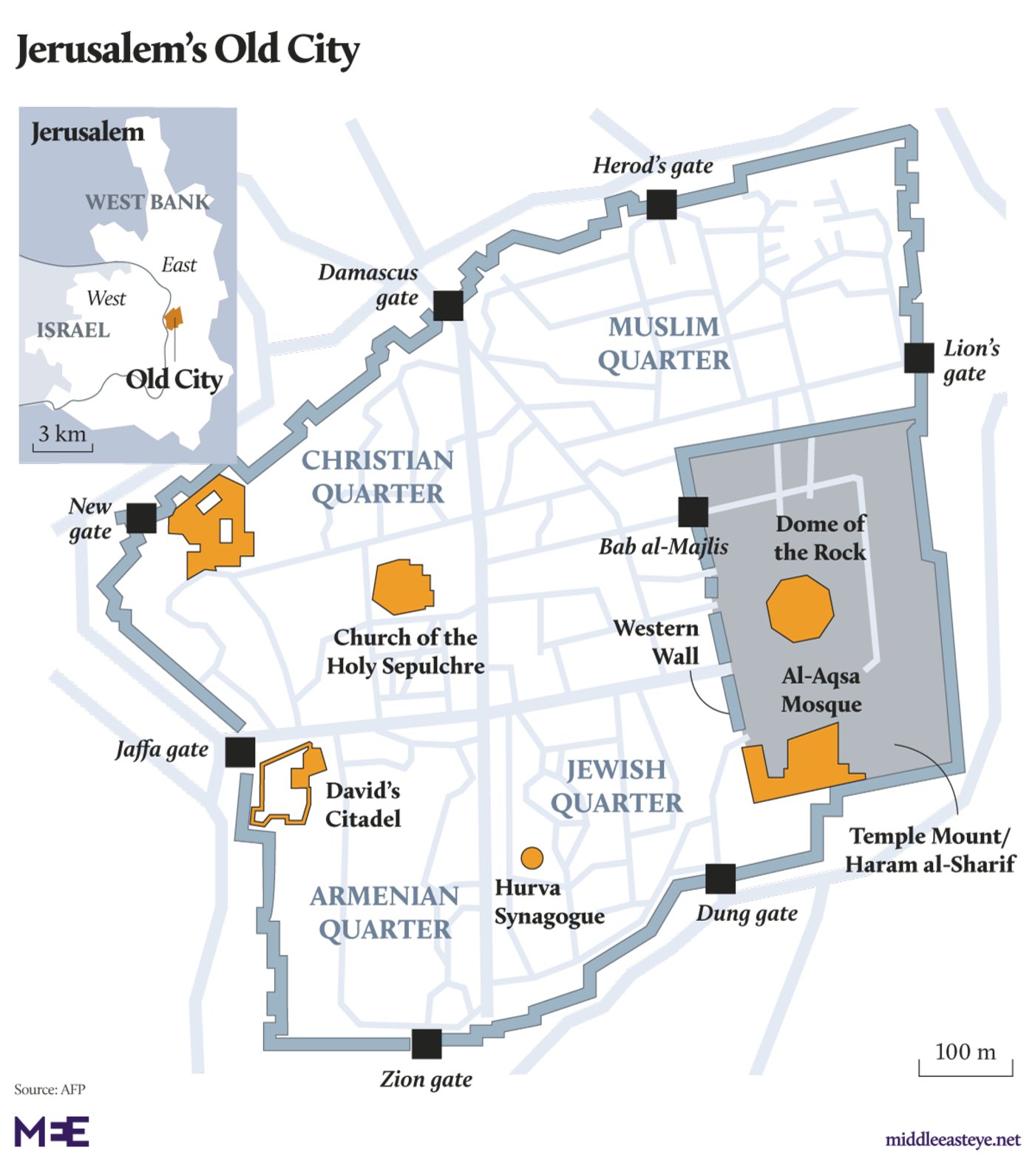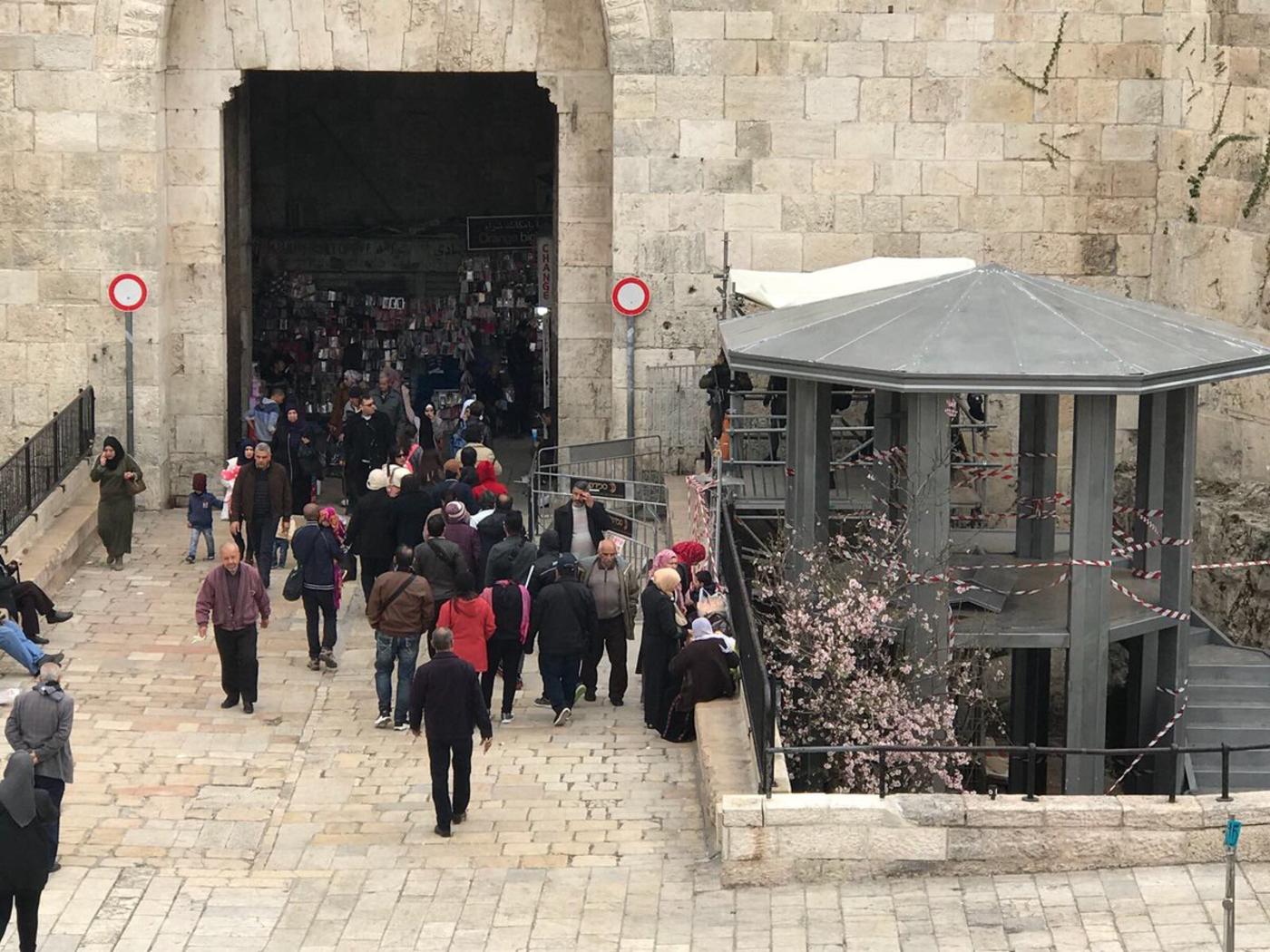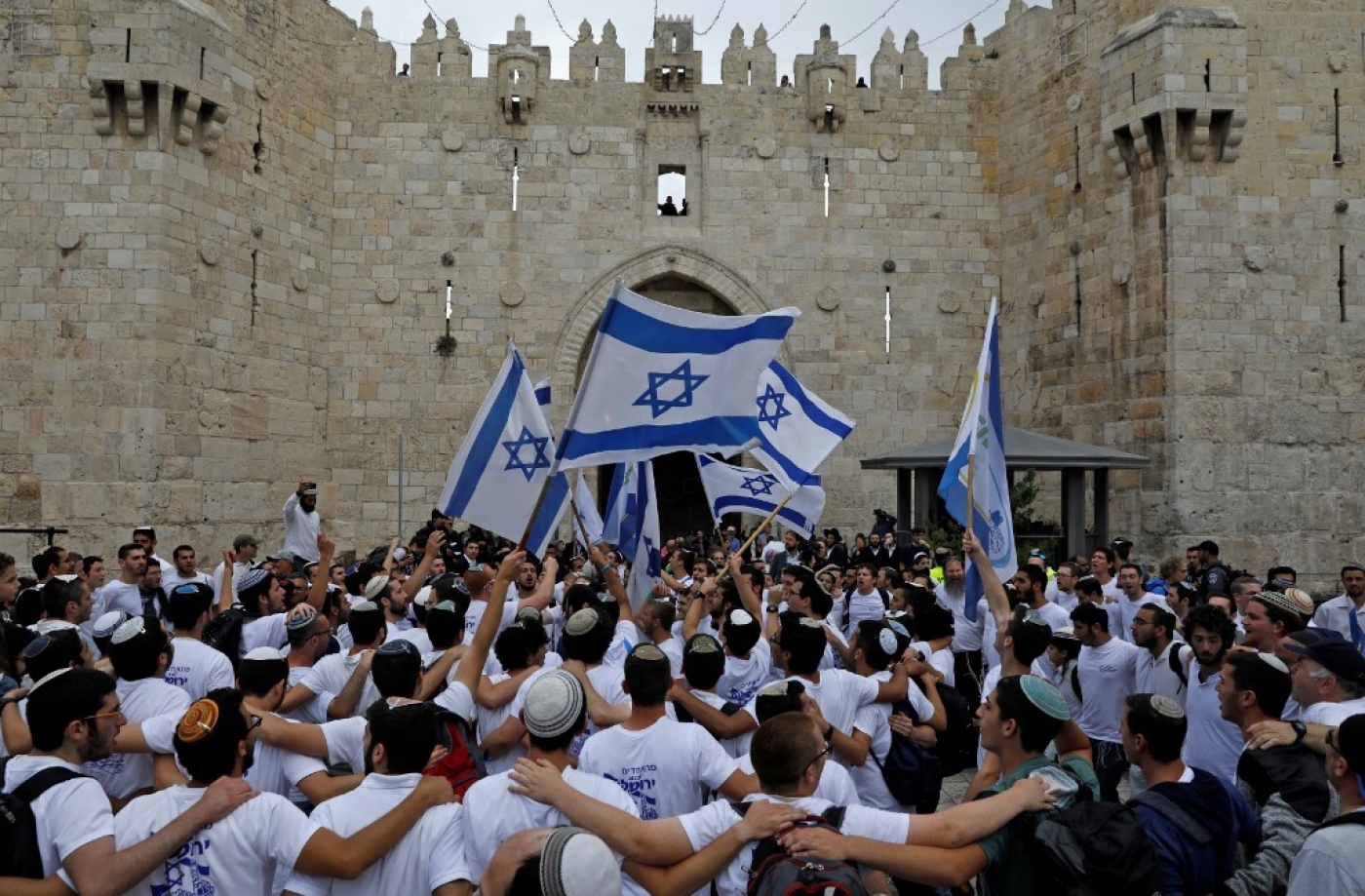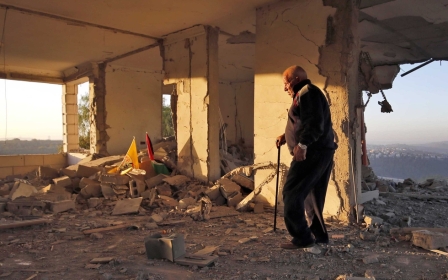Jerusalem's Old City: How Palestine's past is being slowly erased

Israel has controlled East Jerusalem and the walled Old City since the 1967 war in which it also occupied the adjacent West Bank. It has effectively treated them as annexed territory ever since.
To consolidate its grip on the Old City, it has demolished homes and expelled Palestinian residents, empowered Jewish settlers, and imposed sweeping restrictions that make it virtually impossible for most Palestinians to pray at the Al-Aqsa Mosque, one of the holiest sites in Islam.
Done deal: How the peace process sold out the Palestinians
+ Show - HideMiddle East Eye's "Done Deal" series examines how many of the elements of US President Donald Trump's so-called "deal of the century" reflect a reality that already exists on the ground.
It looks at how Palestinian territory has already been effectively annexed, why refugees have no realistic prospect of ever returning to their homeland, how the Old City of Jerusalem is under Israeli rule, how financial threats and incentives are used to undermine Palestinian opposition to the status quo, and how Gaza is kept under a state of permanent siege.
-
Annexation: How Israel already controls more than half of the West Bank
-
Refugees: How Trump’s ‘deal of the century’ is doomed to failure
-
Jerusalem's Old City: How Palestine's past is being slowly erased
-
Gaza: How the Palestinian enclave has been strangled
-
Financial aid: How dependency on donors leaves Palestinians trapped
The final status of the Old City has been the subject of various proposals ever since the United Nations’ 1947 partition plan, which proposed that it should fall under a special international regime, separate from the division of historic Palestine into Arab and Jewish states because of its shared importance to Muslims, Jews and Christians.
The Palestinians claim East Jerusalem, including the Old City, as the capital of a future state, while Israeli leaders have claimed Jerusalem as the state's “eternal capital” since 1949.
The Old City has huge historic, economic, religious and now national symbolism for both Palestinians and Israelis, particularly because of the Al-Aqsa compound, known as Haram al-Sharif to Muslims and Temple Mount to Jews. This is the most explosive issue in an already incendiary conflict.
New MEE newsletter: Jerusalem Dispatch
Sign up to get the latest insights and analysis on Israel-Palestine, alongside Turkey Unpacked and other MEE newsletters
Trump endorsement
But US President Donald Trump’s decision to move the American embassy in Israel to Jerusalem in May 2018 appeared to pre-empt negotiations determining Jerusalem’s status by implying US recognition of exclusive Israeli sovereignty over the city.
Washington’s endorsement for such a move in any proposed peace plan - including Trump's infamous "deal of the century" - would not, however, mark the first time that it has suggested that the Palestinian claim to the Old City should be brought to the negotiating table.
At talks in 2000 between Israeli Prime Minister Ehud Barak and Palestinian Authority President Yasser Arafat, hosted by US President Bill Clinton at his Camp David residence, US mediators proposed dividing sovereignty over the Old City.
According to the US proposal, Israel would take the Jewish and Armenian quarters, with the Palestinians getting the Muslim and Christian quarters.
Israel, however, demanded exclusive sovereignty over East Jerusalem, with the Palestinians having merely administrative authority over the Old City’s Muslim and Christian Quarters.
Seven years later, at Annapolis, Israeli Prime Minister Ehud Olmert evaded the sovereignty issue by proposing instead a temporary international trusteeship administered by Israel, the Palestinian state, the US, Jordan and Saudi Arabia.
More than half a century of Israeli occupation has left its physical and political mark on the Old City. Along with East Jerusalem, the Old City is ruled over by a Jerusalem municipality run by Israeli officials.
After occupying the Old City in 1967, Israel quickly sought to secure control of the area immediately next to the Western Wall, demolishing dozens of homes in a Moroccan neighbourhood and expelling many hundreds of Palestinian inhabitants to create a large prayer plaza.
The Jewish Quarter was also re-established, though Israel converted many former homes into synagogues and seminaries for religious Jews.
Shrinking Palestinian population
Palestinians have been unnerved by the number of physical changes around Al-Aqsa and the neighbouring Muslim Quarter that appear to be designed to strengthen Israel’s control not only over the Western Wall but the mosque compound too.
This has included extending tunnels under homes in the Muslim Quarter to make more of the Western Wall accessible. Benjamin Netanyahu’s decision to open a Western Wall tunnel exit in 1996 led to clashes that killed dozens of Palestinians and 15 Israel soldiers.
Israel has denied the Old City a master plan, making it all but impossible for Palestinians to expand their homes to cope with population growth.
In fact, rather than growing over the past decade, the Palestinian population has shrunk by 2,000, now down to 32,000 residents. Most have left for other areas of Jerualem or the West Bank.
The lack of vacant space in the Muslim and Christian Quarters has prevented Israel from building Jewish settlements there, as it has done elsewhere in East Jerusalem. It has therefore assisted settler organisations in taking over existing Palestinian homes.
There are now about 1,000 Jewish settlers living in the Muslim and Christian Quarters, according to Ir Amim, an Israeli organisation campaigning for equal rights in Jerusalem. These settlers constitute a quarter of the Jews living in the Old City.
Ateret Cohanim, a settler group, has been at the forefront of these incremental takeovers of Palestinian homes, threatening blackmail, using Palestinian collaborators as middlemen to make purchases, and seeking evictions in the Israeli courts.
Currently, 20 Palestinian families in the Old City face evictions, according to Ir Amim.
Settlers have also been taking over properties in the Christian Quarter owned by the Greek Orthodox church, apparently using each new Patriarch’s dependence on Israel’s approval of his appointment as leverage to force through the sales.
'Death to the Arabs'
Every Jerusalem Day, an Israeli holiday celebrating the capture of Jerusalem in 1967, settlers march in force through the Muslim Quarter, chanting “Death to the Arabs” and intimidating local residents.
A rally by Palestinians inside the Al-Aqsa compound this year was broken up by Israeli security forces who entered the site firing rubber bullets and stun grenades. Settlers were able to march through the site.
Aviv Tartasky, of Ir Amim, notes that the expansion of Jews living in the Muslim and Christian Quarters brings more aggressive and invasive policing operations that make life harder for Palestinians, further pressuring them to leave.
Over the years, Israel has made it even harder for Palestinians to access the Old City.
Despite Al-Aqsa’s central place in Islamic worship, almost none of the two million Palestinians from Gaza have been able to reach Jerusalem since the mid-1990s, when the coastal enclave was sealed off by Israel with a fence.
Israel’s wall and checkpoints have separated Palestinians in the West Bank from Jerusalem, leaving most struggling to reach the Old City too.
And while Palestinians within Jerusalem have traditionally accessed the Old City via the northern Damascus Gate, Israel has made the gate less appealing by increasing the presence of armed police there, providing them with a guard tower, and conducting regular security checks on Palestinian youths.
After 1967, Israel and Jordan agreed on a so-called “status quo” for Al-Aqsa: the Waqf, a Jordanian-led Islamic trust, would administer the compound while Israel would be responsible for security outside. In addition, only Muslims would be allowed to pray at the site.
In practice, Israel’s interpretation of that agreement has strengthened its hand by allowing it to control who has access to the compound. Sweeping restrictions mean only older Palestinians, and a few who receive permits, are now allowed to access Al-Aqsa for Friday prayers.
Israel has regularly operated inside the compound too. It shuttered a prayer room, Bab al-Rahmeh, in 2003 after it was renovated by a popular Palestinian religious leader in Israel, Sheikh Raed Salah.
Despite holding Israeli citizenship, Salah has been banned from entering the Al-Aqsa compound for more than a decade. Israel blocked Waqf-led efforts to reopen Bab al-Rahmeh in February, leading to clashes with Israeli security forces and a temporary bar on Waqf leaders entering Al-Aqsa.
In 2015, Israel also banned volunteer male and female civil guards, the Mourabitoun, from the compound after confrontations with Jewish visitors to the site. But Israel had to climb down in 2017 after it installed surveillance cameras and tried to force Palestinian worshippers to pass through metal detectors.
Meanwhile, Israelis have been staking ever stronger claims to control of the compound. In 2000, Ariel Sharon, then opposition leader, marched into the site backed by hundreds of armed guards, triggering the Second Intifada.
And since the ban on the Mourabitoun, Israeli police have failed to enforce rules banning Jews from praying in the compound, according to watchdog groups.
Israeli politicians, including government ministers, have become increasingly sympathetic to settler demands to divide the site to allow for Jewish prayer.
Even more hardline groups wishing to destroy Al-Aqsa and build a new Jewish temple in its place have become more mainstream in Israeli society in recent years.
In the two years from 2016 to 2018, the number of Jews reported entering the compound more than doubled, from 14,000 to 30,000.
Christians squeezed out
Christian residents suffer similar problems to Muslims, including planning restrictions and efforts by settlers to take over properties.
But Christians also face specific pressures. As a very small community, they have been severely isolated by Israel’s policy cutting off Jerusalem from the West Bank and Christians in Bethlehem and the Ramallah area.
Israel’s denial of the right of Jerusalemites to live with a West Bank spouse in the city, or register their children, has hit the Christian community particularly hard, forcing many to move into the West Bank.
Also, a dramatic downturn in tourism for many years after the eruption of the Second Intifada in 2000 left many Christian families in the Old City in financial trouble because they depend on income from souvenir shops and work as tour guides.
A move last year by Israel to tax Church property in Jerusalem was reversed after the Church of the Holy Sepulchre was shuttered in protest.
But it was seen by Christians as a further sign that their community is under assault and that Israel views them as an obstacle to its efforts to “Judaise” the Old City, said Yousef Daher, of the Jerusalem Interchurch Centre, located in the Old City.
Daher noted that rather than growing, as would be expected, Jerusalem’s wider Christian population has declined from 12,000 in 1967 to a total of 9,000 today.
Although there are no official figures, he estimated that no more than 2,400 Christians remained in the Old City. He added that Palestinian Christians find it easier to leave the region because of their connections to overseas churches and the fact that they often have relatives abroad.
Shopping mall and a cable car
Israeli access to the Old City, traditionally via the Jaffa Gate on the western side between the Christian and Armenian quarters, has been facilitated by the new luxury Mamilla shopping mall, which effectively serves as a bridge from West Jerusalem’s city centre.
Israel is now seeking to turn Dung Gate, on the south-eastern side and leading into the Jewish Quarter, into the main entrance. The difficulty is that Dung Gate abuts the Palestinian neighbourhood of Silwan.
Ir Amim notes that Dung Gate is seen by Israel as an important gateway for the settlers as they intensify their takeover of Palestinian homes in East Jerusalem, part of efforts to encircle the Al-Aqsa compound.
Israel is therefore building a cable car that will carry visitors from West Jerusalem over Silwan directly to a settler-run compound. From there, visitors will be able to enter above ground through Dung Gate or underground through tunnels running below the Old City walls to surface at the foot of the Western Wall.
Palestinians and Israeli activists are concerned that the purpose is to direct Jewish and foreign visitors away from the Muslim and Christian quarters, both to conceal the Palestinian presence in the Old City and to starve Palestinian shopkeepers of the traditional trade from those passing through Damascus and Jaffa gates.
This article is available in French on Middle East Eye French edition.
Middle East Eye delivers independent and unrivalled coverage and analysis of the Middle East, North Africa and beyond. To learn more about republishing this content and the associated fees, please fill out this form. More about MEE can be found here.








